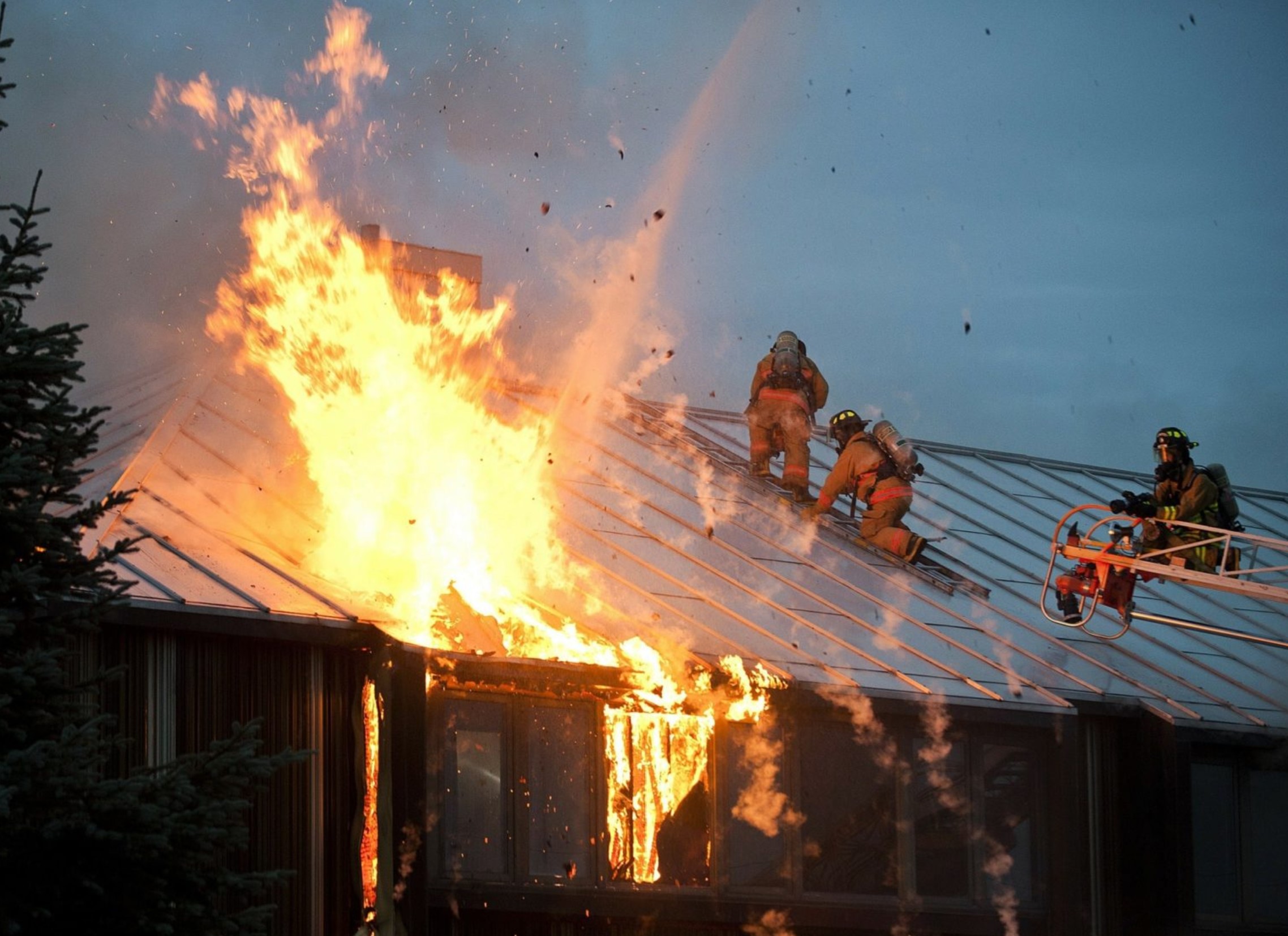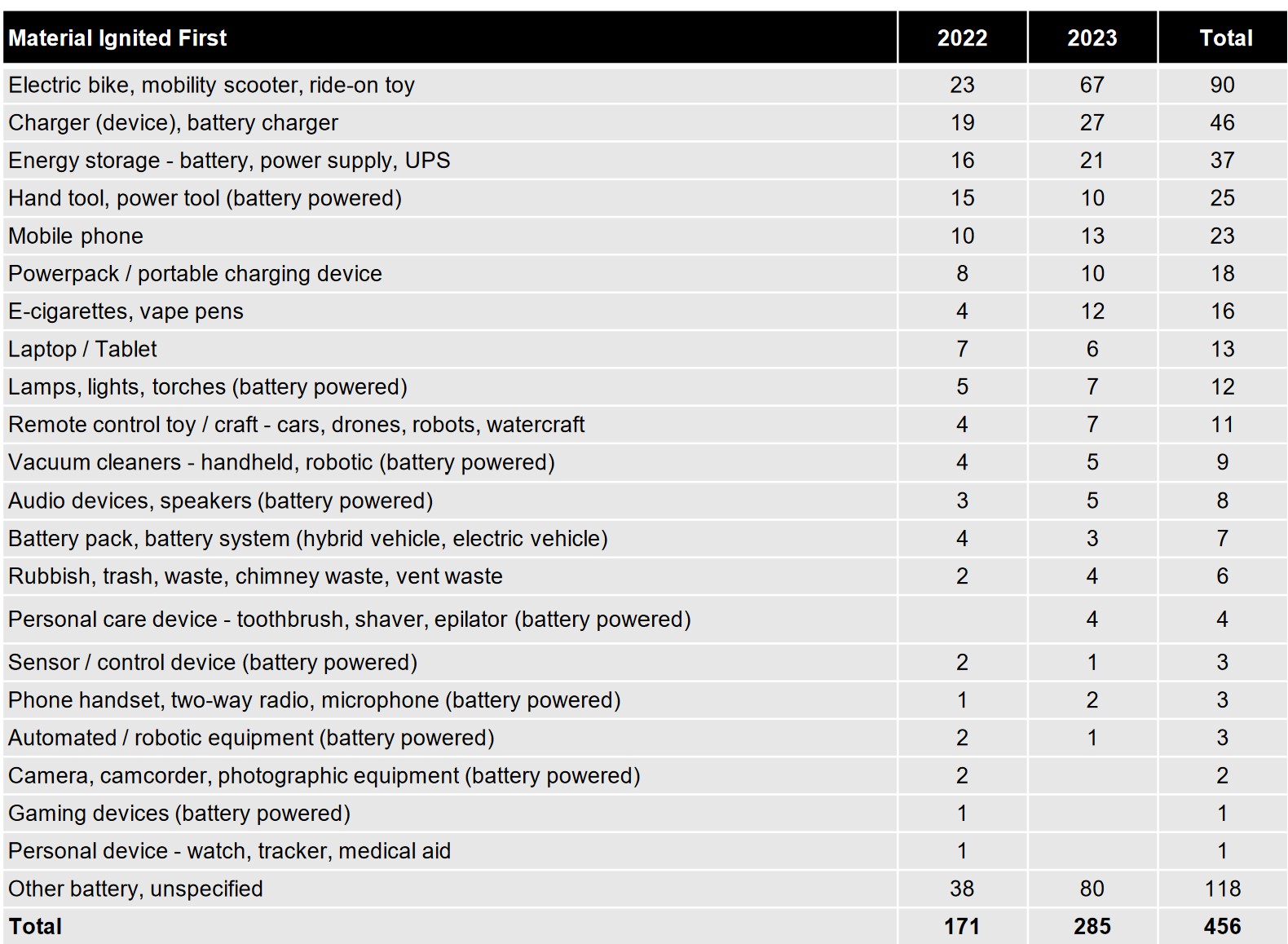Warning – 164 Lithium-ion battery fires in 6 months in NSW alone

Lithium-ion battery fires have exploded in NSW to 164 in the first six months of 2024. That compares to 67 for the whole of 2023 and 23 in 2022. Extrapolating the NSW data to the entire country, we could face over 3,000 needless, extremely dangerous fires this year—equivalent to 60 a week.
This projection is three times the number of fires in 2023.
We’re talking about consumer-oriented fires caused by everyday items like e-scooters, e-bikes, household appliances and power tools. Unfortunately, these fires have an injury rate four times higher than other types, underscoring the human cost of this issue.
These stats below are for 2022/2023 but show the prime offenders for Lithium-ion battery fires.

Lithium-ions’ physical and chemical properties are such that once a fire occurs, there is a large exothermic explosive reaction. Those fumes are toxic, and then the environment can become really dynamic.
Fire and Rescue NSW Deputy Commissioner Paul McGuiggan.
This seven-minute video from ABC is confronting and worth watching.
Enter a new threat – embedded Lithium-ion batteries in Vapes
The Waste Management and Resource Recovery Association is grappling with a staggering 12,000 fires annually, all ignited by embedded discarded lithium-ion batteries. This relentless onslaught has led to the loss of waste recycling facilities and trucks ‘every couple of weeks’, posing serious threats to the safety of its workers.
The risk has increased exponentially with embedded lithium-ion in vapes, smartphones, AirPods, cordless power tools, vacuums, and e-mobility devices.
We can’t deal with hazardous items that create a risk—items that burst into flames and will hurt our workers and our equipment. It is a massive issue.
Re.Group chief development officer Garth Lamb.

Why the explosion?
By far, the largest contributor is lithium-ion-powered e-bikes, e-scooters, and e-skateboards. There is no legal requirement to certify the battery packs or management systems.
Next is the Christmas ‘fad’ of buying children lithium-ion-powered toy ‘pedal’ cars, scooters and trikes.
The common denominator is ‘cheap.’ This means lower-quality lithium-ion batteries, poor battery management systems, and unreliable chargers. Even though importing electrical goods without R-NZ c-tick certification is an offence, the country is flooded with substandard imports.
The most common areas impacted by fires are bedrooms and lounge rooms, which contain a high proportion of highly flammable fixtures and fittings. Lithium-ion battery fires starting here invariably lead to a whole-home loss. These are not places to charge devices.
Special issues for multi-level strata titled buildings
Most Body-Corporate By-laws do not have regulations regarding bringing e-mobility devices or larger (100W capacity or more) lithium-ion powered devices into the building, let alone charging them in the apartment.
While ‘towering inferno’ is perhaps too dramatic, a 10-storey apartment was evacuated due to an e-bike fire on the third floor. The older style block would have been destroyed if not for quick action.
If you own a strata title property, it is time to demand that your body corporate manager implement lithium-ion rules.
The Owners Corporation Network (OCN), an independent body representing apartment owners, has drafted a model by-law on the management of e-bikes and e-scooters after a series of fires sparked by lithium-ion batteries. If adopted by strata schemes, the by-law would also ban residents from storing or charging e-bikes on the property.
OCN board chair Fred Tuckwell said e-bikes and e-scooters are a clean mode of transport but we need to ensure safe storage and charging.
Caravans, motorhomes, campers and boaties are now in danger
There are safe portable power stations using LiFePO₄ (Lithium-Iron Phosphate), with no risk of thermal runaway. We have tested and recommend Bluetti and Anker Powerhouse – see our reviews here.
There are absolutely unsafe ones using Lithium-Ion batteries. These flood Amazon, eBay, Kogan, Gumtree, and Chinese sites like Temu and Shien. However, reputable retailers still sell lower-cost lithium-ion ‘bombs’ in portable power stations and 100-240AH battery packs. So it is not all about where you buy it.
Worse still, there are DIY ones using disparate inverters, chargers, solar MPPT controllers, solar panels, lithium-ion battery packs, battery management systems and accessories sold online, in supermarkets (think Aldi Specials), grey nomad camping outlets, auto parts, and hardware stores.
Recently, a caravan with a faulty Lithium-ion battery pack caught fire, destroying the van in minutes and severely damaging a neighbouring van.
Who is liable if your Lithium-ion battery explodes?
Most would automatically think the vendor should replace the unit and pay for the damage. Or insurance should be liable. Wrong—you are 100% liable, and what is worse, if you are in a strata apartment, you are liable for the entire multi-story building restoration.
It is called a duty of care, and most fires are caused by a lack of supervision and charging near flammable items. Any inadvertent breach lets vendors and insurance companies off the hook.
CyberShack has prepared a few guidelines you must read and follow to use such power safely.
- Planes and power banks – FAA/TSA rules enforced – vital if you use a USB power bank
- Does insurance cover a lithium-ion battery fire? Maybe and probably not – no, it does not!
- Is there a safe way to charge Lithium-ion batteries – no, but you can make it safer.
- Large-capacity Lithium-ion batteries will end in death
- Lithium-ion e-scooters, e-skateboards, and e-bikes banned on UK on public transport
How to reduce the possibility of lithium-ion battery fires
- Disconnect products as soon as they are fully charged
- Charge batteries on non-combustible surfaces away from flammable items.
- Use compatible chargers and avoid mixing and matching brands.
- Always purchase replacement batteries and charging equipment from reputable suppliers or follow the manufacturer’s instructions.
- Regularly check the batteries for signs of damage, including cracking, denting, swelling, and leaking, as well as heating up or emitting smoke.
- Safely dispose of damaged or used batteries at a recycling drop-off point.
- Have a working smoke alarm in rooms where you charge or store batteries.
Brought to you by CyberShack.com.au







